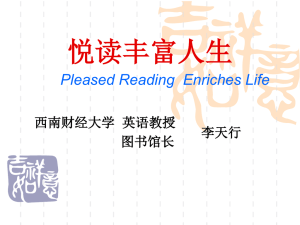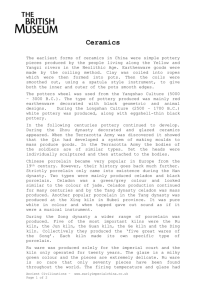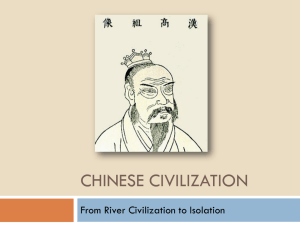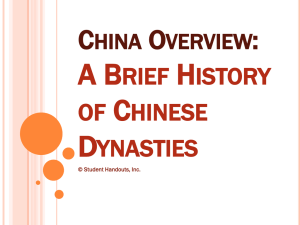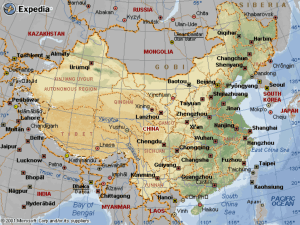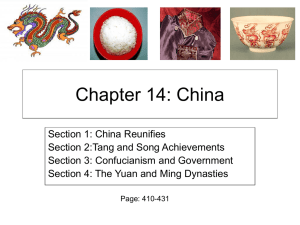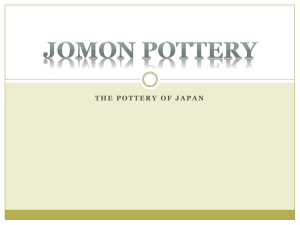Ceramics-China, Japan,Korea
advertisement
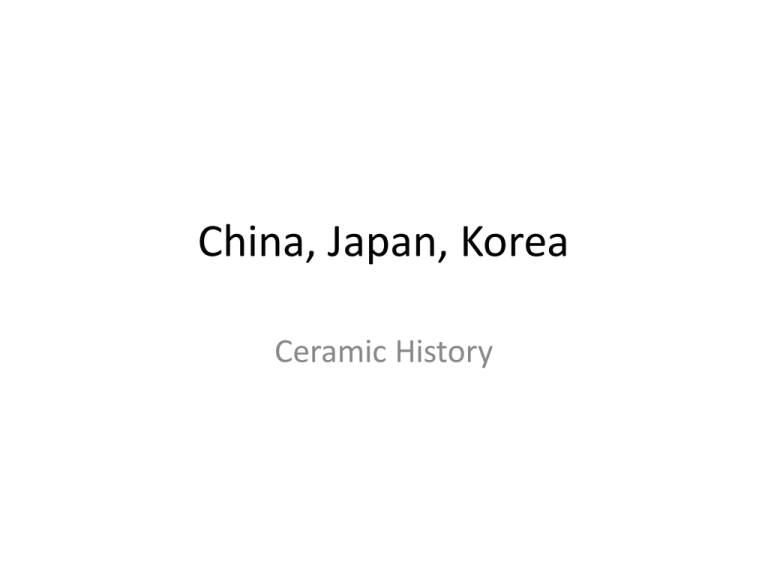
China, Japan, Korea Ceramic History Neolithic China • Settlements developed along the two main river systems. • In the North, the Yellow River • In the South, the Yangzi River – North, wheat, corn, soybeans – South, rice – Pottery first coiled perhaps 18,000 BCE. Potter’s wheel introduced 3000 BCE Yangshao Dawenkou Shang Dynasty – Bronze Age China 1800-1100 BCE The Emperors Army Emperor Ch’in Shih-huang-ti Qin Dynasty 221-206 BCE Army of Emperor Shi Huangdi Shaanxi Province, China 210 B.C.E. painted terracotta The Han Dynasty 206 – 0 BCE Development of the Silk Road, Expansion and Trade Development of early porcelain object for trade. Press Molds continued to be used to create large ceramic pieces for tombs. Horse and chariot from Han Dynasty. Hunping (Soul Vases), Han through Six Dynasty Period Sculptural compositions on the lid of the pot. Hunping Note the row of Buddhas, this is one of the first representations of Buddha in China. Buddhism arrived in the Han Dynasty. Most of what we know about early Asian architecture is derived from clay models such as this Han Dynasty house that was placed in a tomb. Figurines of court attendants, like these jesting entertainers, were placed in the tombs of nobility. Wu Ti´s reign (141-87 B.C.) was a period of great military expansion during the Han Dynasty. He expanded China’s borders into Vietnam and Korea and pushed north and west. Wu Ti transplanted an estimated 2 million people to the northwestern region in order to colonize these areas. One of the great prizes of northern expansion was the discovery of “Celestial Horses” – large, strong bodied horses that were imported into central and southern China. The horse is one of the most common motifs in Chinese art of this period. After the Han, Chinese history enters into a period of competing kingdoms and dynasties that lasts until the Tang Dynasty is established in 618. Trade along the Silk Road continues and the horse continues to be venerated. Brick, Sui Dynasty, 265-589 CE Silk Road Tader, Northern Wei Dynasty. Approx. 386-584 CE Northern Wei Court Figurines, 386-584 CE Chinese art often depicts fantastic, spiritual animals. They too appear as figurines. Tang Dynasty 618-906 The Tang was a period of political stability, wealth, expanding trade and cultural flowering. Ceramic figurines depicted trade animals, foreigners and court life. Tang Dynasty 618-906 • The Tang was a period of political stability, wealth, expanding trade and cultural flowering. Ceramic figurines depicted trade animals, foreigners and court life. Tang Sancai or Tri-Color Glaze Mineral oxides were added to a lead based low-fire glaze to achieve the characteristic yellow, brown and green Tang Glazes. The clay was a low fire red clay. Throughout the early and middle Tang they were a primary export. Horse 8th to 9th century C.E. 20 in. high glazed earthenware The Tang Dynasty also saw the beginning of the porcelain export trade in China. By the end of the Tang, porcelain had replaced earthenware as the primary clay of export. Phoenix Vase, British Museum, Late Tang Dynasty. Yaozhou Ware describes the carved pottery produced by a kiln complex in central China from the late Tang Dynasty, through the Song, to the Yuan Dynasty. Stoneware clay. High Fire. A master dish would have been carved and fired, from which a convex ‘hump-mould’ was taken. This mould then acted as the template for multiple dishes to be formed. The glaze was then applied, pooling in the crevices and laying thinly on raised areas. Through firing, the pooled areas grew darker in colour and the thinly glazed areas more transparent, thus creating illusion of light and shadows in the surface design. Robert Jacobson on the mold making procedure for Tang and then Five Dynasties ceramics. Jacobson is the curator of Asian Art at the Minneapolis Institue of Art. Yeah, basically the way this goes—keep in mind if you will a kind of ceramic mound that's been carved; this very floral design has been carved around that. This is hard—it's fired. What the Chinese potters would do is simply take the clay, push it down until it covered the entire mound, and then pare it down on the wheel to the thinness that we see here. They allowed it to dry a bit, and then simply popped it off and would have had this design worked into it. Five Dynasties (907-960) porcelain with impressed design Song Dynasty Ceramics Elegant Court Porcelain, Expressionistic Glazes and Gestural “Village Ware” • Northern Celadon - porcelain clay and celadon glaze. In the Song Dynasty there were five famous kilns: Ru Kiln, Imperial Kiln, Jun Kiln, Ge Kilin and Ding Kiln. This crackle glaze is typical of Ge Ware. Guan ware, pictured in your book, is another prized type of crackle ware. These works contrast the simple, refined form of the vase with the spontaneity of the cracks which vary with each piece. Northern Celadon Jun Ware • It can be identified visually by its coarse stoneware body and its thickly applied glaze, which through firing gained an opalescent blue colour. At the edges the glaze ran thin, becoming semi-transparent and creating the simple and elegant colouring of this piece. While some Jun wares use only the blue glaze, it was also common to apply copper brushwork to dry glazes in broad strokes or washes, which then merged with the bluish Jun glazes at full heat. This resulted in the bold splashes of purple-red visible in this bowl. Expressionistic “Oil Spot” glaze on stoneware clay. Cizhou Ware • This pillow is an example of Cizhou ware, a type of ceramic made in the northern part of China during the Jin dynasty (1115-1234). The term Cizhou encapsulates a range of wares made in several regions of northern China, often consisting of a stoneware body decorated with a bold design.Ceramic pillows were an important item in the kilns producing Cizhou wares, and were made for both funerary use and as a neck support for the living. Cizhou ware pillow, white clay slip over stoneware with iron decoration. Meiping vase 960-1127 C.E. Stoneware, Cizhou type with sgraffito decoration Chizou type vase with sgraffito decoration Visit this Chizou pillow at the Walters Museum! After the Song Dynasty comes the Yuan Dynasty (1279-1368) which is notable in Chinese history as a time of Mongol rule. In ceramics, porcelain development continued with a focus on the development of blue and white ware. During the Yuan (and then the Ming Dynasty) the imperial kilns were at Jingdezen, still a center of porcelain production Modeling and press molding continued to play a role in ceramic production. These Yuan pieces are incense burners. The Ming Dynasty (1368-1644) saw the return of Chinese ethic rule. It also saw the ramping up of porcelain production, particularly to Europe. In addition to achieving a great mastery of blue and white (cobalt on porcelain) ware, the Ming Dynasty also developed ware that combined high fired porcelain glazing with a second, low-fire, enamel painting. The technique of firing enamels onto glazed pottery had begun in the Middle East. Qing Dynasty 1644-1911. Noted for the development of new enameling processes and an emphasis on color and ornament. The scholar’s plate below is an example of fencai, a process that achieved soft, pastel colors with enamels. Hard rather than soft enamel technique, yincai, from the Qing Dynasty 1644-1911. It would be wrong to categorize the Qing as just a period of opulence. Work from this period was varied and could also seek simplicity in meaning and materials. For example these Yixing wares were prized for the color of the clay which was left bare and burnished. Storage jar, Middle Jomon period (ca. 2500–1500 B.C.) JapanEarthenware, unglazed H. 27 1/2 in. Cord-marked pottery is the characteristic ware of the earliest inhabitants of Japan. These Neolithic people, known as the Jomon (cord-marking) culture, existed on the abundant fishing and hunting on the Japanese islands from at least the fifth millennium B.C., surviving in some areas until the third century A.D. The cord-marked herringbone pattern was reproduced by cords knotted together and twisted in opposite directions. All Jomon pots were made by hand, without the aid of a wheel, the potter building up the vessel from the bottom with coil upon coil of soft clay. As in all other Neolithic cultures, women produced these early potteries. The clay was mixed with a variety of adhesive materials, including mica, lead, fibers, and crushed shells. After the vessel was formed, tools were employed to smooth both the outer and interior surfaces. When completely dry, it was fired in an outdoor bonfire at a temperature of no more than about 900° C. Deep bowl with sculptural rim, late Middle Jomon period. ca. 1500 B.C Japan Earthenware H. 13 in. During the middle Jomon period, communities were larger and rims of pots began to take on flamboyant shapes. Irregular shape of rim may indicate some kind of ritual use. Dogu – Middle to Late Jomon Period Yayoi Period 300 BCE – 300 CE. Smoother pottery, use of clay slips. Concurrent: development of metalurgy. Kofun Period 300-555 Haniwa • Haniwa were placed at the top of the burial mound, in the center, along the edges, and at the entrance of the burial chamber of enormous tombs constructed for the ruling elite. Haniwa warrior figure from Gunma Prefecture, Japan 5th to 6th century C.E. low-fired clay 49 1/4 in. high Asuka/Nara Period 552 CE – 794 CE Sue Ceramics Ash Glazes and the Potter’s Wheel Figurative Sculpture In clay, as well as wood Nio or Guardian from Toudaiji Goryeo Celadon Ceramics Inlaid Slip, Celadon Glaze Melon shaped Ewer (pouring vessel)

